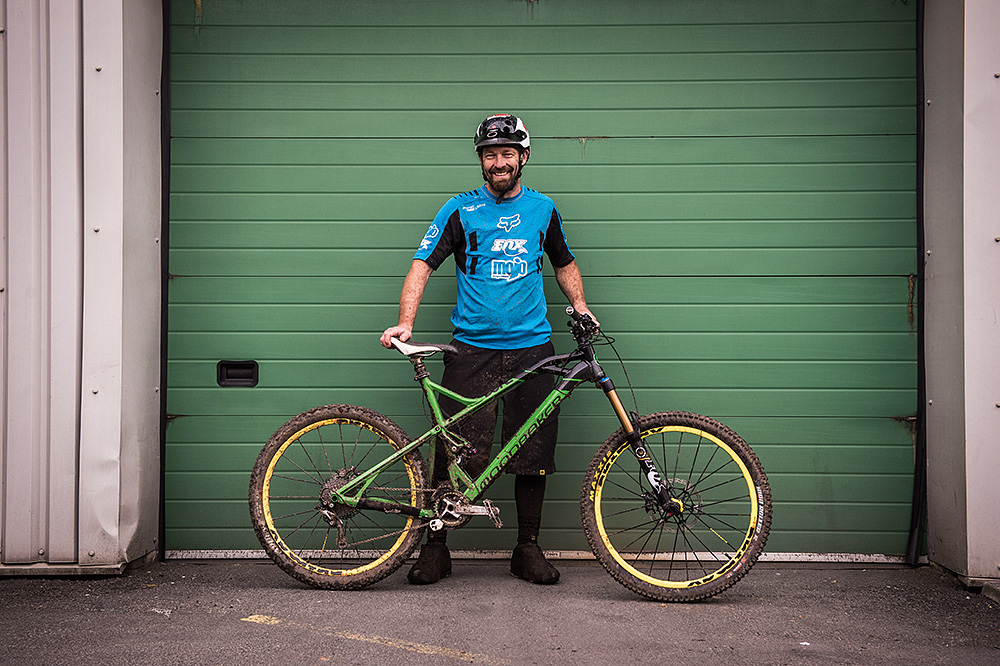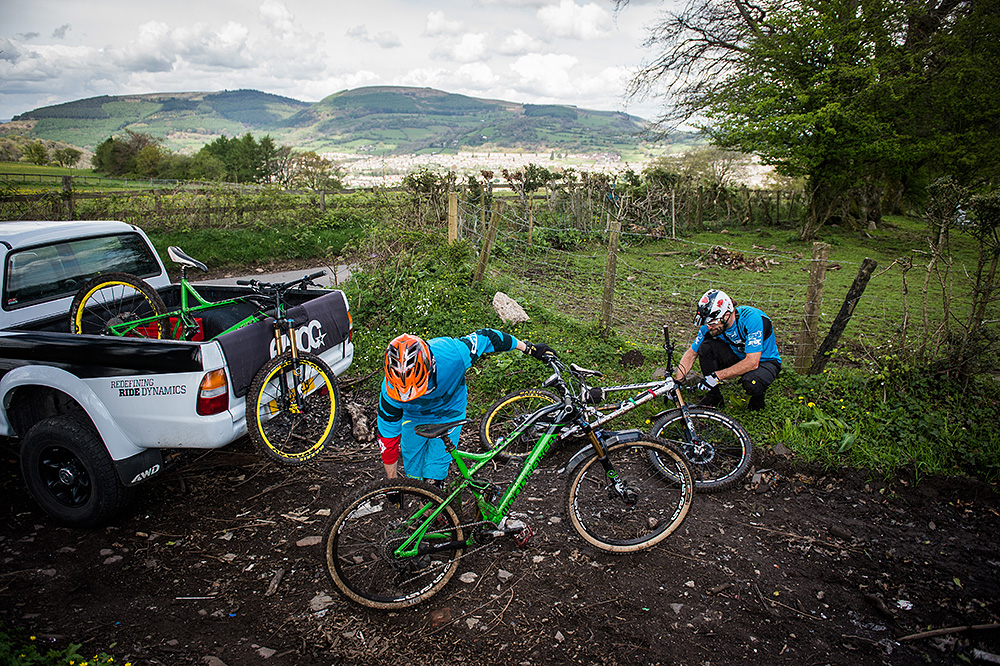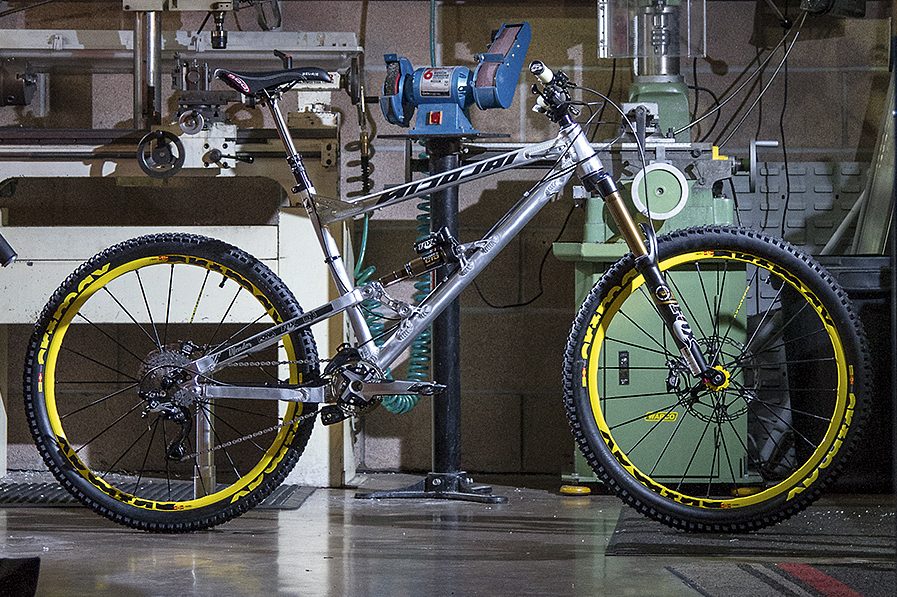Chris Porter, big chief at Mojo Suspension and habitual bike tinkerer, explains his frustrations with the conservatism and convention of the bike industry
Why is it so difficult to buy long, low and slack trail bikes?
It’s a question I often find myself asking. And so follows an attempt to find some answers, with apologies to Mondraker, Cesar Rojo and a few quick, enlightened UK journalists. No apologies, however, to the 29er skidders. 😉
Firstly, why is the industry so scared of extreme angles? When Fabien Barel has used head angles of less than 58º (to great success), why do we still think 66º is slack?
- A – Head angle (66º is not slack!)
- B – Seat angle (steep is actually good!)
- C – Bottom bracket height (if you’re not dragging your heels, it’s too high)
- D – Chainstay (short chainstays are great for back hops)
- E – Front Centre (clue: the front wheel should be in front of you!)
- F – Wheelbase (currently toying with 1,320mm on the Nicolai)
- G – Down tube (basically your hands to feet measurement when you stand up to descend)
- H – Top tube (old-school measurement great for road bikes where you spend all your time sitting down)
- I – Reach (with stack is a complicated way of telling you the same thing as the down tube)
When you break down the geometry of a bicycle into separate parts it’s actually not that difficult to figure out what’s going on:
If you want to do backhops, get a short rear centre. For anything else you do on an off-road bicycle, you don’t need a short rear centre. If you want to load the front wheel ‘through’ the pedals you’ll need a longer rear centre.
The steeper the head angle, the less you need to lean to achieve a certain cornering arc; great for trials, great for getting round the gates on the canal towpath; not so great for safe, off-road speed.
The higher the BB the more the weight transfer, for better front wheel braking. Changes of direction and manuals are easier too, but a low BB will bring you greater mid-corner stability.
A bigger wheel rolls over bumps better than a smaller wheel… zzzzzzzzzzz. Sorry, sent myself to sleep there with those fairy tales.
“Move any bicycle geometry measurement (that includes wheel diameter) in one direction and it will make something better and something worse”
But here’s the rub. Move any bicycle geometry measurement (that includes wheel diameter) in one direction and it will make something better and something worse, move it in the other and that something will likely get worse as the other thing gets better. Big wheels and steep head angles aren’t good, it’s just that when bike designers first fitted big wheels into frames they simply made the chainstays longer to accommodate them and allow riders to load the front wheel (I use the term designer loosely here). The bars were also accidentally higher which gave more room for the rider, and the contact patch is longer and flatter which quietens the bump and surface camber steer, even with a tiller of a stem. These are all good things… It feels like a ‘normal’ wheeled bike with a decent bar and a slack head angle! Woo hoo!
But there are bad things too. Just as the larger circumference wheel doesn’t slow down as much on the bump face, so it won’t speed up as much on the back of the bump, rock, root or whatever. No pump, in other words. It’s obviously bigger, but it’s also heavier! So you get a worse sprung to unsprung-weight ratio. Putting that into basic terms, while the wheel goes over the bumps better, the suspension will be much worse. And they accelerate and decelerate more slowly too. Consult your GCSE physics for the details, but put basically, you are adding rotating weight. Incidentally, the low BB in relation to the front axle is also considered a good thing in that it allows the weight on the pedals to push under the front axle at the point of impact, helping to lift the front wheel over the bump. The flip side to that is that when you want to load that front contact patch, those lower feet are also pushing the front wheel on – bad thing for braking.
Because there is less wrap round on the cross-ply tyre carcass to the rim, the tyres roll off the rim more easily. So as 29ers veer from XC to Enduro territory the rims are getting wider and the tyres heavier, and the sprung to unsprung-weight ratio gets worse and the acceleration and deceleration suffers. Oh, and because the hub dimensions didn’t change when the designers got the bigger circle down, there is less spoke angle so the wheel is weaker as well as heavier. Sure 29ers feel OK, even very good in some circumstances, just the small problem of having to drop £2.5K on the carbon wheels to sort them out. You get the feeling they designed themselves into a 29-inch diameter hole and can’t get back out. But they won’t give up, bless ‘em.
“If their riders are struggling with bumps, they consult the suspension experts. They don’t employ a primary school kid to draw a bigger circle”
I use the wheel size analogy because it shows the way most of the bicycle industry develops a theory relating to geometry, or indeed most other design elements. Can you imagine how that would go down with Honda or KTM testing for motocross (which incidentally shares the same outside tyre diameter as a 27.5 x 2.3in or a 26 x 2.8in)? If their riders are struggling with bumps, they consult the suspension experts. They don’t employ a primary school kid to draw a bigger circle. Incidentally, they did try bigger wheels in the 1970s and they tried smaller wheels in the 2000s – tried and failed.
Another nice little illustration of how the industry works is the clutch mech and thick/thin chainring nonsense. When a rear suspension system moves through its arc it requires chain growth – which is accommodated for by the rear mech. So, if we ‘clutch’ that rear mech, we are adding a friction damper to the rear suspension system. Again we make the suspension a bit worse, but this time to keep the chain on? Which it doesn’t fully achieve anyway. That’s hardly a win/win situation, is it? Try a rough downhill run with the chain removed to feel how good the rear suspension can be, and how much faster the bike goes without motive power! Since writing this Neko Mulally did exactly that at the World’s when a mechanical issue turned into his best result ever – watch it for yourself in the video below.
So the development process is more novelty led than performance led. Emperor’s new clothes, anyone?
Maybe it’s because manufacturers build to the lowest common denominator? Maybe they build bikes to feel OK to the slowest, weakest riders? I don’t know, this I’m still trying to work it out for myself. But then I’m someone who rides a trail bike with a 63º head angle! And that’s only because I can’t find a bike I can make even slacker.
So you run a slack head angle on a bike and it works very, very well at speed and is much safer on the steep stuff. The opposite side of the coin is that the bars feel like they flop a bit at low speed, and you need to lean the bike over a bit more to steer when going at low speeds. That’s the sum total of negatives; not many then.
A bad designer and a lazy bike tester will take these negatives and say it won’t climb. As they ride the slack(ish) bike with no thought to locking their core muscles and taking control of the bike, the bars flop from side to side and the bike gets the blame for the rider’s failings. Neither will that designer/tester get the benefit of the slack head angle, because he or she will probably be too timid to take control of the bike, push it into the turns and feel the handling benefit, and won’t take on very challenging terrain anyway. So this combination of bike designer and tester will end up making canal towpath bikes; bikes built to feel nice at the bars for easy tracks, easy climbs, easy descents.
The only way to understand the effects of geometry changes on handling is to build it and try it, back-to-back, and re-try the original settings to verify the findings. It must all be done with a stopwatch (because it doesn’t lie), with feel as a secondary element (because that does lie).
Add into the mix that the only fast riders trying the stuff that the slow guys are designing (with apologies to Cesar) are a) employed by the companies and probably don’t want to upset them and lose their meal ticket, b) probably happy to ride round problems for a free bike and c) not using stopwatches anyway.
It’s a wonder any company ever releases a genuinely new development in geometry. Still, at least we get sweet, pastel coloured, cartoon graphics – awesome!
Why wouldn’t the slower rider be better off on the best performing, safer geometry and accept the bar flop and the need for a bit of core strength work? Maybe he/she would also be a bit quicker too? Maybe if someone explained that jamming the seat forward in the rails will get you a better climbing angle and saddle/crank relationship, he/she would climb with more comfort too. He/she might even buy a bigger bike (the right size) instead of a longer stem. It seems more important for the industry to hide cables, colour match components and devise ‘standards’ that turn out to be anything but.
Honestly, if MotoGP teams are still learning how to get a bike round corners then it’s way too complicated for the bicycle industry
But while it’s simple in principle, it starts to get really complicated when you try to figure out how to fit all of these geometry elements together to achieve performance over a broad spectrum of circumstances. And I mean really complicated. A 2D drawing of a relatively simple bike that looks great on paper (or a CAD screen), gets massively complicated when you lean it over and ride around a corner. Even more complicated when you add a dynamic rider, who makes up around 80-90% of the vehicle mass, and suspension changing the relationship between the wheels and the chassis too. Honestly, if MotoGP teams are still learning how to get a bike round corners and still improving then it’s way too complicated for the bicycle industry, and certainly too much for me!
Not many people who understand two-wheeled, singletrack, vehicle chassis dynamics actually have jobs in the bicycle industry, and even fewer have the balls to try something ‘different’ when it comes to geometry. Like the fashion industry, everyone wants to copy whatever’s popular, and we end up with the bicycle equivalent of X-Factor; just because something’s popular doesn’t mean it’s good. If you followed this train of thought to its logical conclusion you’d end up with every single manufacturer making heavy, rigid bicycles with 4-inch wide tyres. In all seriousness, that would be stupid wouldn’t it?
Author: Chris Porter
Outta the archive: Chris Porter’s pioneering Mondraker from 2014
"For me, the limits are around 62.3° head angle, 850mm for the front centre and 335mm for the BB height.…
Size matters: why we’re all riding bikes that are too small
Chris Porter explains why he thinks mountain bike designers are getting it all wrong
Looking back at Chris Porter’s pioneering custom Nicolai Ion 2014
From the MBR Achive: How the boss behind Mojo and Geometron was pushing bike design lower, longer and slacker way…










